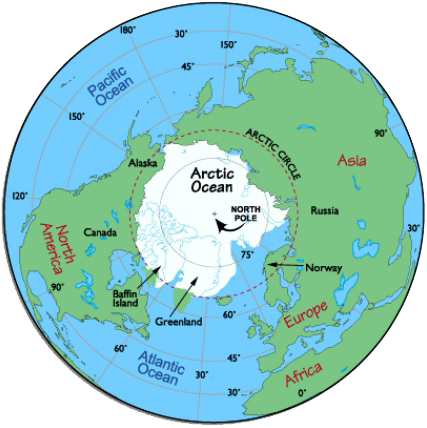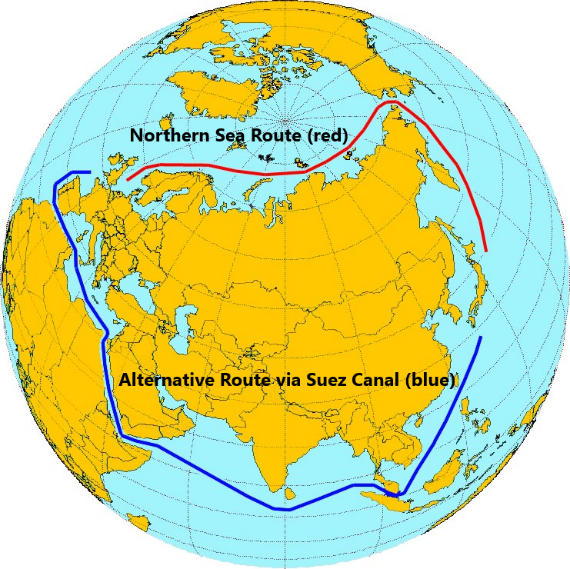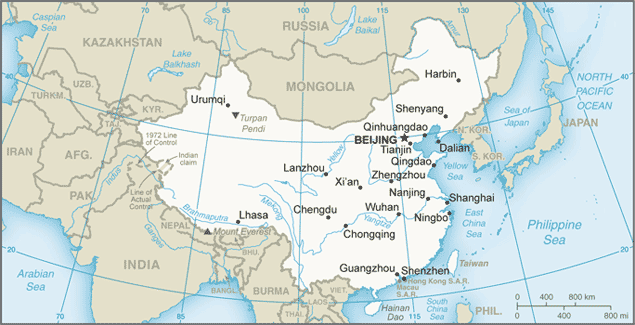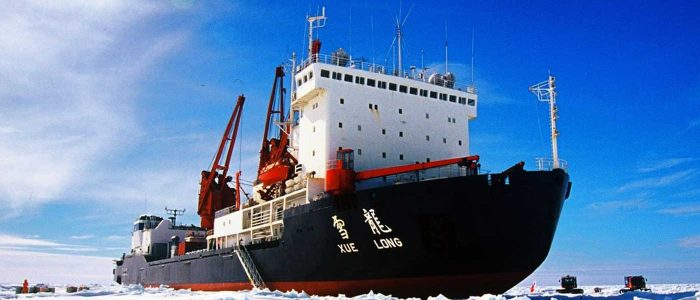Introduction
China recently issued a white paper announcing its Arctic Policy which emphasized the significance of the Arctic region. It also focused on natural conditions that have direct impact on China’s climate and environment and in turn on its economic interests in agriculture, forestry, marine industry and other sectors. The melting of ice in the Arctic region creates possibility of new trade routes which would be potentially much shorter than the traditional route of transportation through Panama Canal or Suez Canal for China. This may ensue China’s ambition of constructing ‘Polar Silk Road’ (PSR) connecting the north eastern passage with traditional north-western passage. In addition to trade routes, Arctic region holds untapped mineral, hydro-carbon resources as well. It was this characterization of the region and its significance that China pledged to announce its official policy regarding Arctic region. This move from China came after it achieved an observer status in the Arctic Council in 2013 after years of persistent scientific research in the region.
A new report emphasized that competition for economic advantage and greater influence over an area of increasing geo-strategic importance could lead to contentious relations among stakeholders.
In contrast to China, America has already issued its revised strategy to protect its national security interests in the Arctic region in December, 2016. A new report emphasized that competition for economic advantage and greater influence over an area of increasing geo-strategic importance could lead to contentious relations among stakeholders. This may increase risk of disputes between Arctic and non-Arctic nations over access to Arctic shipping lanes and natural resources. This scenario is going to present an extension of the interest driven global system at the North Pole.
In this milieu, the aim of this paper is to deliberate on the significance of the Arctic region, and how China intends to benefit from the region as intended in its policy, alongside interests of other countries, particularly the US.
Conceptualizing the Arctic Region

The Arctic is the polar region north of the Arctic Circle, or north of the latitude 66° north of the equator shown in the Figure 1. During the June solstice, there are 24 hours of sunlight in the Arctic and during the December solstice, the sun never rises. The eight countries of Finland, Sweden, Norway, Iceland, Greenland (under the Danish monarchy), Canada, the United States (Alaska) and Russia make up the Arctic. The arctic region of the world is the northernmost area of the world covering approximately 14.5 million square kilometers (5.5 million square miles).
For regulating Arctic affairs, the countries have also formulated a Council in which China is observer (rest of the observers are India, Italy, Japan, South Korea, Spain, France, United Kingdom, Germany, Poland, Singapore and Switzerland).
Arctic Council
The eight claimant states Finland, Sweden, Norway, Iceland, Greenland (under the Danish monarchy), Canada, the United States (Alaska) and the Russian Arctic combine to form the Arctic Council. The mandate of the Arctic Council affirms is to promote cooperation, coordination and interaction among the Arctic states on the common issues, particularly on issues of sustainable development and environmental protection in the Arctic. However, the mandate of Arctic Council explicitly excludes military security.
The domain of the Arctic council is established through six working groups:
- The Arctic Contaminants Action Program (ACAP)
- The Arctic Monitoring and Assessment Program (AMAP)
- The Conservation of Arctic Flora and Fauna Working Group (CAFF)
- The Emergency Prevention, Preparedness and Response Working Group (EPPR)
- The Protection of the Arctic Marine Environment (PAME) Working Group
- The Sustainable Development Working Group (SDWG)
The governance of the Arctic Council is handled through the consensus among the eight Arctic States and through involvement of permanent members. The implementation of Arctic Council’s decisions and recommendations is not its responsibility, rather each individual state has to conform if it agrees to them.
China’s Policy

The map (figure 2) shows two important routes of transportation for China. The passage through Northern Sea Route (red) makes distance smaller as compared to route from Suez Canal (blue).

According to Guo Peiqing, the routes from any Chinese ports above north of latitude 30° shown in the above map (figure 3) to European and American ports will be potentially shortened by at least 40 per cent.
The trip from Shanghai to Hamburg via Northeast Route is 6400 kilometers shorter than the traditional route via Malacca Straits and Suez Canal. China regards its heavy use of Malacca Straits as a strategic vulnerability; it wants diversification of sea-lanes. The observer status of China in the Arctic Council has also increased importance of its Arctic policy.
The white paper also describes official policy of Chinese government on the Arctic region which is a resource-rich region. It has been estimated that Arctic contains up to 30 per cent of the world’s undiscovered gas and 13 per cent of the world’s undiscovered oil resources. Geographically, China is a ‘Near-Arctic State’: one of the continental states that is closest to the Arctic Circle. As per a paper which was issued by the State Council Information Office, ‘the natural conditions of the Arctic and their changes have a direct impact on China’s climate system and ecological environment, and, in turn, on its economic interests in agriculture, forestry, fishery, marine industry and other sectors.’
The Chinese Arctic Policy formulates the following four aims:
- China will participate in the development of Arctic shipping routes which are composed of the North-east Passage (the shipping route to the Pacific Ocean, along the Arctic Ocean coasts of Norway and Russia), North-west Passage (the sea route to the Pacific Ocean through the Arctic Ocean).
- China aims to participate in the exploration for and exploitation of oil, gas, mineral and other non-living resources in the Arctic.
- China will start utilizing fisheries and other living resources and participate in conservation.
- China will develop Arctic tourism, which will be an emerging industry in coming years. China will help and exhort enterprises to cooperate with Arctic States in developing tourism in the region. Beijing has constantly expressed its interest in the polar region for years.
The China’s Arctic policy looks to actively participate in Arctic affairs as a self-declared ‘near-Arctic State’ and play a major role in the Arctic. China has constantly expressed its interest in the polar region (North & South poles) for years. By sharing ‘interests with Arctic States,’ China hopes to work with all parties to jointly build a ‘Polar Silk Road,’ and facilitate connectivity and sustainable economic and social development of the Arctic.
The China’s Arctic policy looks to actively participate in Arctic affairs as a self-declared ‘near-Arctic State’ and play a major role in the Arctic. China has constantly expressed its interest in the polar region (North & South poles) for years.
At present, the charter of the United Nations, the United Nations Convention on the Laws of the sea (UNCLOS) and the Spitsbergen Treaty along with the general international law govern Arctic affairs. China has made it clear in the white paper that it enjoys freedom or right to use Arctic resources to pursue its own interests of scientific research and resource exploration in high seas, navigation, laying of submarines cables and pipelines. As a permanent member of the UN Security Council, China shoulders the important mission of jointly promoting peace and security in the Arctic. But, the pact which was signed at the end of 2017 to off-limits Central Arctic Oceans (CAO) from commercial fishing could lead become a bone of contention due to active moves of major global powers like China, because it has voracious appetite for food security.
An Appraisal
The China’s Arctic policy shows relevance to the revised American Arctic policy announced in Dec, 2016. The US Policy is directed to maximize capacity in order to secure American strategic interests in the Arctic region. This American policy would assert duress for other countries like China that are moving towards Arctic region. China, which is one of the largest economies of the world, has opted officially for expansion towards Arctic region. It is looking for more resources and diversification of trade routes which are possible by going through the North Pole because it will solve China’s Malacca dilemma. The China’s Arctic policy will also impact its peripheral countries like Japan. In current development, Japan will also try to maximize its influence in the Arctic region.
Findings
The China’s Arctic policy with the declaration of ‘near Arctic State’ is, indeed, a declarative statement, but it comes with a lot of insecurities for the regional states. The US has also revised its Arctic policy in 2016 to increase its capacity in Arctic region in order to secure its strategic interests. The other littoral states and non-littoral states are also highly concerned about the outcome of a policy that may lead to a race among world major power in Arctic region. The China’s Arctic policy is a result of its desire to get a hold of new resources and diversify its economic routes. This would in return create strain among the other peripheral states, besides attracting more countries to show interest in exploration of Arctic Region, thereby substantiating the assertion that interest of more countries in Arctic Region may become contentious. The revised strategy of US for Arctic region may escalate rivalry between Washington and Beijing over the issues of commercial fishing, though China has signed treaty which has forbidden commercial fishing for next 16 years in Arctic seas.
Conclusion
In the backdrop of China’s Arctic policy, China is considering more economic and trade routes for expansion of its trade. But, this move of China will also encourage other nations to run for resources and mineral exploitation in the Arctic region. This quest for Arctic region will lead to a complex and long-term rivalries among major world powers.
